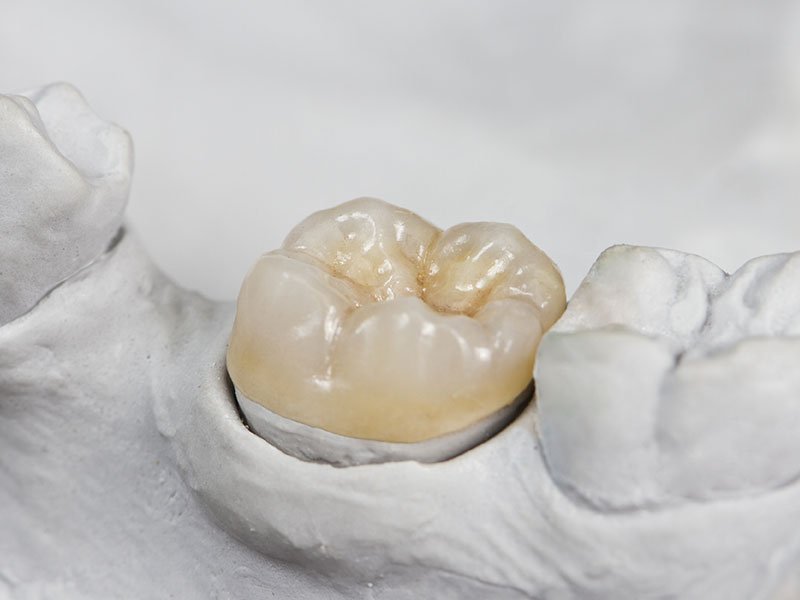
Restorative
Dentistry
“I recommend the same treatment for my patients as I would my family.” – Maryam Talaie, D.D.S.
Plan Your Visit Now
Begin the Change
Resin composite (tooth colored) filling
Reasons for composite fillings:
- Replace existing filling
- Decay/cavity
- Protect root surface due to gum recession
- Chipped or broken teeth
- Worn down teeth
- Close gap between two teeth
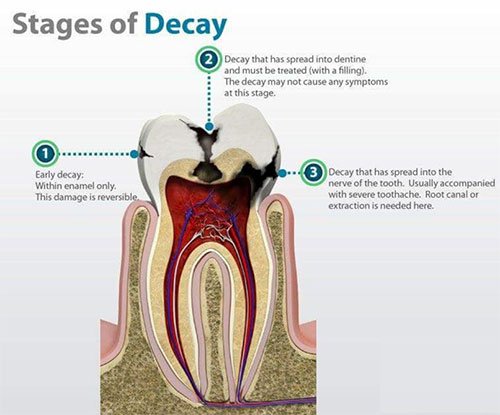
Resin composite (tooth colored) fillings are used to repair a variety of conditions related to a tooth. They are essentially the material used in tooth-colored fillings and fixing small chips. Century Smile does not use mercury amalgam for fillings, but Dr. Talaie is experienced in safely removing and replacing them. Resin composite fillings are tooth colored and are closely matched to the color of surrounding teeth. They are also more aesthetically suited for use in front teeth or the more visible areas of the mouth. Composite fillings are durable and can last a few years but depending on habits, bite and other factors, they get worn down, or cavities form in other areas of the tooth. Insurance will typically pay for a replacement filling on a single tooth once every two years. Every time the tooth is repaired with a filling, more tooth structure is needed to be removed, potentially resulting in need of a partial or full coverage crown.

Composite fillings are placed in one appointment unless there are several to do in other areas of the mouth. If a patient is scheduled for multiple fillings, we may need to break up the appointment and focus on one side of the mouth at a time. Dr. Talaie will always try to accommodate a patient with a busy schedule and perform as much needed dental work per visit as possible.
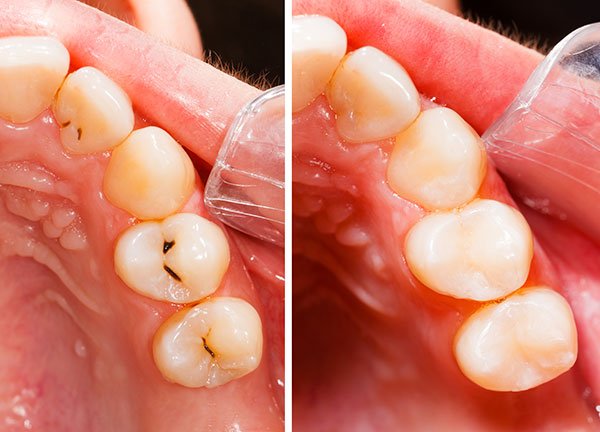
While the tooth is numb, Dr. Talaie will remove any old filling and decay as necessary. Space will then be thoroughly cleaned and carefully prepared for the new filling. If the decay was near the nerve of the tooth, a special medication could be applied for extra protection-at no additional charge to the patient. The composite filling will then be precisely shaped and polished, restoring your tooth to its original shape and function. Sensitivity to cold or when chewing is rare but normal and should subside in a few days. Throbbing pain or heat sensitivity in a tooth is a concern and should be addressed.
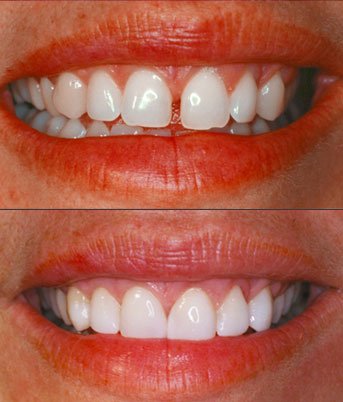
Resin composite can also be used to close gaps between teeth or be added to a tooth to make them look longer. They are used to fix small chips and breaks on front teeth as they can be easily matched to your natural tooth.
Gum recession occurs when the gum tissues have receded, exposing the root surface made of pure dentin and not protected by enamel as your teeth above the gum line are. Dentin is soft compared to enamel and more sensitive to temperatures. Patients with gum recession complain of sensitivity or develop cavities on the roots due to being exposed. Dr. Talaie can cover those recession areas with resin composite and protect the root surface much like enamel would. For major gum recession, a gum graft may be indicated.
Click here for more information on gum graft procedure
Inlays, Onlays & partial crowns
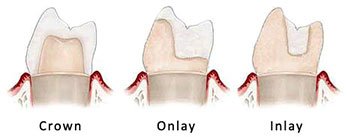
When a tooth needs to be restored, the amount of remaining healthy tooth structure is important to conserve- if possible. However, if the amount of surface space the tooth needs to be filled is too large for a resin composite filling, but there is adequate healthy tooth structure, then the next option is an inlay, onlay or partial crown.

Full coverage crowns replace all of the tooth structure above the gum line while a partial crown or onlay allows for the healthy tooth structure remaining to be left intact. If the doctor begins working on a tooth to place a filling, but the cavity is deeper and larger than anticipated, a more dependable and durable restoration is needed. A resin composite filling will fall out or break –possibly taking more of the tooth with it. The doctor doesn’t want to remove healthy tooth structure but putting in a regular filling will fail, so there is a middle ground.
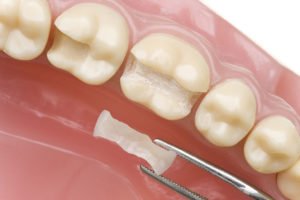
Onlays or partial crowns, made of porcelain, gold, e-max or zirconia, are strong enough to restore your tooth and withstand the biting forces of normal living. They also conserve healthy tooth structure -which is a good thing. Sometimes these advanced restorations are recommended based on visual exam and x-ray, but the depth of the actual tooth decay is not always predictable. Also, most mercury amalgam fillings have decay underneath them, which means more cutting of the tooth. Teeth with old metal fillings tend to have crack line due to food and drink temperature fluctuations (metal expands and contracts to heat and cold). Onlays and partial crowns are great when used to restore teeth with instability from previous dental work because they can reinforce the tooth structure.
Process:
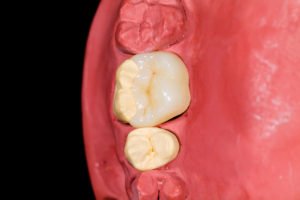
After the patient is numb, the doctor can begin removing the old filling or cavity or both. The tooth is precisely cut and prepared for a dental impression which will be sent to a lab for fabrication. After the tooth is ‘prepped’ by the dentist, an impression or mold is taken for the lab. Next, a temporary filling is placed on the tooth to protect it while the restoration is being made. In a week or two, the final restoration is cemented onto the tooth. It is adjusted, polished and fine-tuned for your bite and comfort.
Dental crown
- Broken tooth
- Decayed tooth
- Root canal treated tooth
- Replacing large fillings
- Replacing ill-fitting crowns & restorations
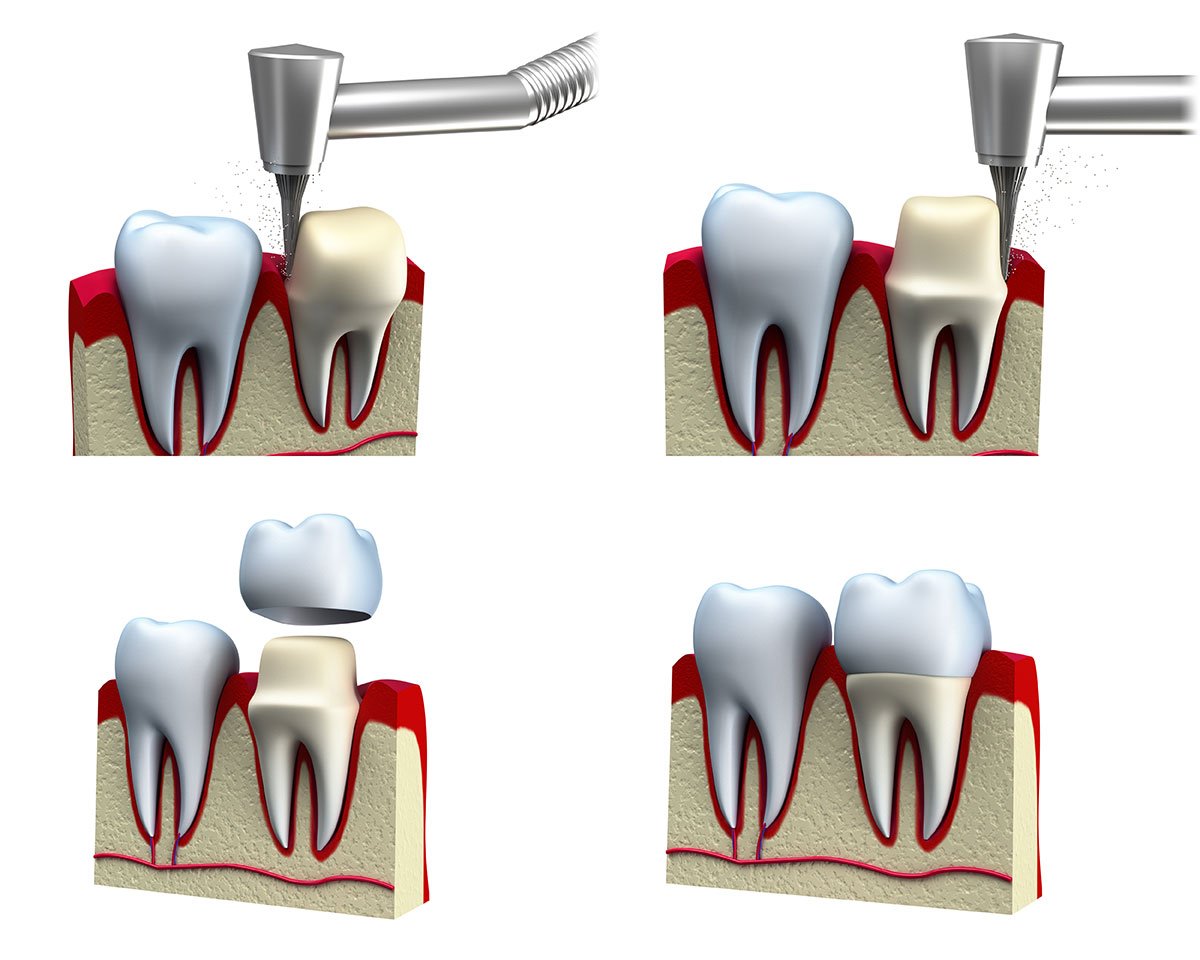
Dental crowns are one of the most common dental restorations used today. They are full coverage as they replace 360° of the tooth structure above the gum line. Attention to detail, skill, and artistry goes into fabricating a well-fitting crown, and it is a collaboration between the dentist and dental lab. Each patient may have specific health conditions or anatomical considerations that may have a greater influence on treatment decisions. Proper home care, oral hygiene, using a night guard appliance, can greatly impact the longevity of a dental crown.
100% porcelain ceramic
- Upgraded material
- Weaker
- Bio-compatible (no metal)
- Best for cosmetic dentistry
- More tooth structure removed
- Can be damaging to opposing teeth
- Not a good option for heavy clencher /grinder
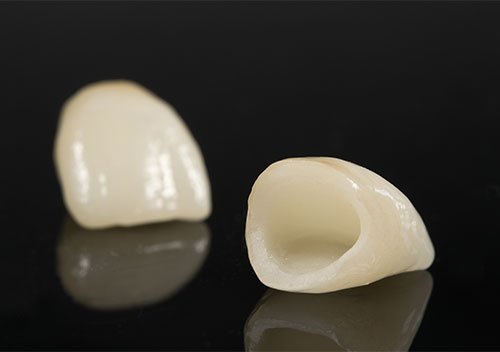
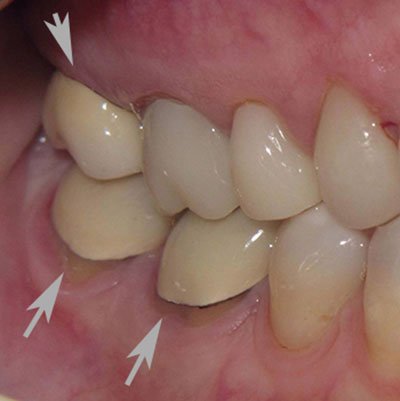
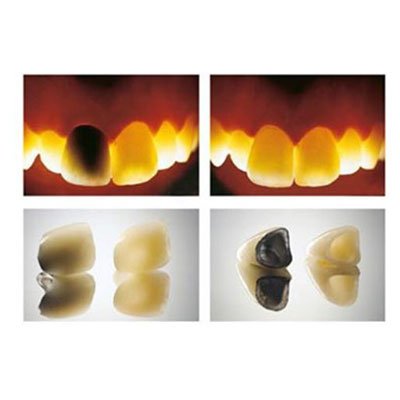
Porcelain fused to metal crown VS. all porcelain
Gold
- Strong and durable
- More expensive
- Less tooth structure removed
- Prolonged sensitivity after placement (will subside)
- Gentle on opposing teeth
- Best suited for back of the mouth molars
- Good for heavy clencher/grinder

Zirconia & zirconia layered porcelain (100% zirconia or zirconia shell with porcelain coating)
- Upgraded material
- More costly
- Stronger and more durable
- Translucent with a better cosmetic result
- Less likely to fracture
- Crowns and bases are milled from digital scans, making the margins extremely accurate
- Best suited for root canal treated teeth
- Good for heavy clencher/grinder


All types of dental crowns have the potential to develop decay at the margins or may need to be re-cemented from time to time with long-term use. Any tooth that requires a filling, partial crown or full coverage crown, may also still develop the need for a root canal, even after the treatment is completed.
Bridge
- For missing tooth or teeth
A bridge is three or more dental crowns connected to close the space between a missing tooth or teeth. The two teeth involved are prepped/ cut, and an impression is taken and sent to the lab. The lab makes three crowns all connected. The middle crown closes the open space while the other crowns are cemented to the other teeth.
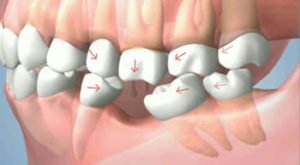
Bridges are not the ideal option for replacing missing teeth.
- Not hygienic, food trap
- Exacerbates bone loss
- Cutting of otherwise healthy teeth to create the bridge
- Damaging to adjacent teeth
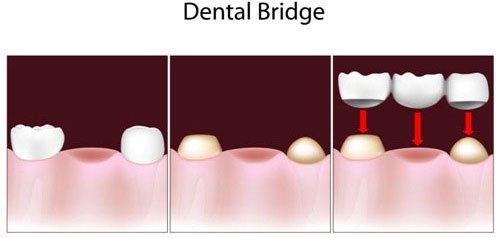
About mercury amalgam fillings and safe removal
Today, mercury amalgam fillings surprisingly are still the most common type of filling placed in the United States. Often referred to as “silver” fillings, are a mixture of mercury, silver, tin, and copper. This material is so common in dental fillings because it is actually the cheapest. Dental insurance companies like to keep payments down, so progression towards better and safer dental techniques are often rejected or downgraded. An example is a resin composite filling will be paid by the dental insurance as an amalgam filling. The fee for an amalgam filling is $25 -$75 less than composite filling. The patient pays their normal 20% co-pay PLUS the difference between the two materials. Some dental plans do cover composite fillings, but most will downgrade the benefit.
Most private dental practices that focus on quality care do not place amalgam fillings and refuse to keep it in stock to offer as a legitimate restorative solution. Working with the material is potentially hazardous, as well as the dentist feeling uncomfortable with placing a filling that may do more to damage the tooth in the long run.
At Century Smile, we do not place amalgam fillings, but we also do not necessarily recommend replacing all of a person’s metal fillings. Mercury exposure from amalgam fillings is greatest when the filling is placed and when it is removed. Each patient is screened tooth by tooth and assessed on how well the filling is holding up or not. Yes, a mercury amalgam filling is not part of our standard of care, but if it is stable in the tooth, we recommend leaving it…for now.
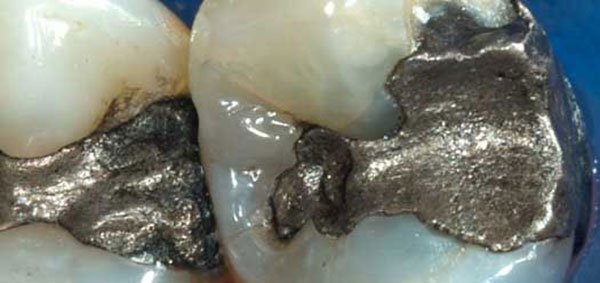
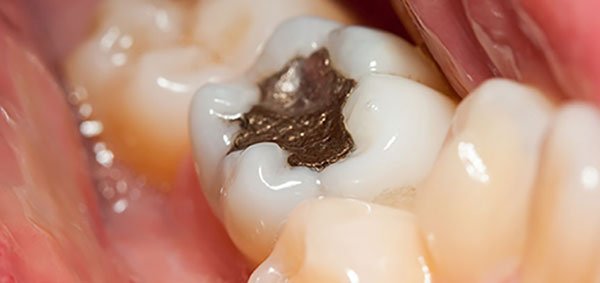
One of the main problems with these ‘silver’ fillings is the fact they are metal and reactive to temperature fluctuations. When we eat hot or cold foods, the exposed teeth, and filling materials expand or contract in reaction to the change in temperature. Small microfractures and cracks appear in the healthy tooth structure surrounding the filling causing instability which over time will be a problem. One of the top emergency phone calls we receive is about old metal fillings breaking off or falling out and always while eating something soft. Another problem with amalgam fillings is they leak and allow for recurring decay to form around and underneath the filling. Close to 80% of amalgam fillings Dr. Talaie removes show decay present hiding underneath the filling. Recurrent decay can happen with all kinds of fillings, but we find it most prevalent in teeth with amalgam fillings.
Removal of amalgam filling:
- Patient gets numb with nova cane
- Patient attached to oxygen and or nitrous (for multiple teeth but optional)
- Use of a sharp, fast diamond bur drill and copious amounts of water to cut the amalgam in large chunks and reduce vapor
- Special high-speed suction quickly vacuums the cut amalgam and any mercury vapors.
- Residual amalgam and decay (if any) is removed
- The tooth is prepared for a crown, partial crown, onlay or resin composite filling (if small enough)
- The impression is taken to the dental lab, and a temporary crown or temporary filling is placed.
- Patient returns 1-2 weeks later for final placement of crown, partial crown or onlay






Give Us A Call At 310.836.6161 Or Request An Appointment Online






